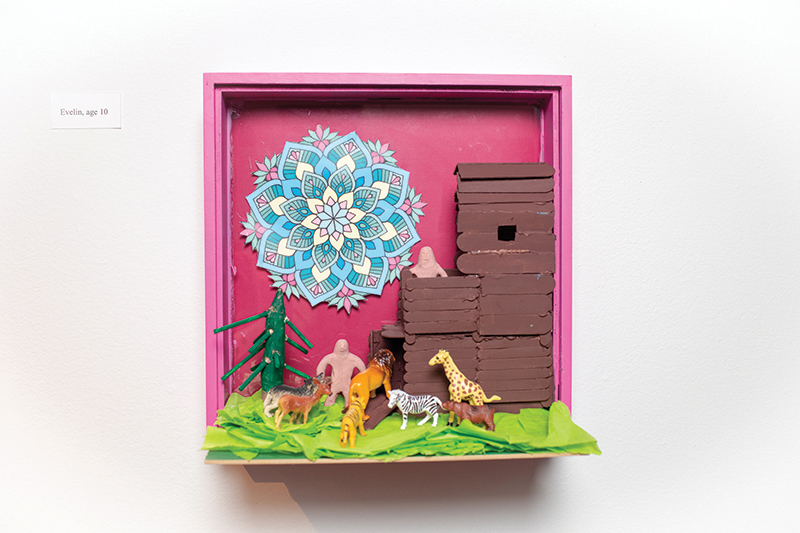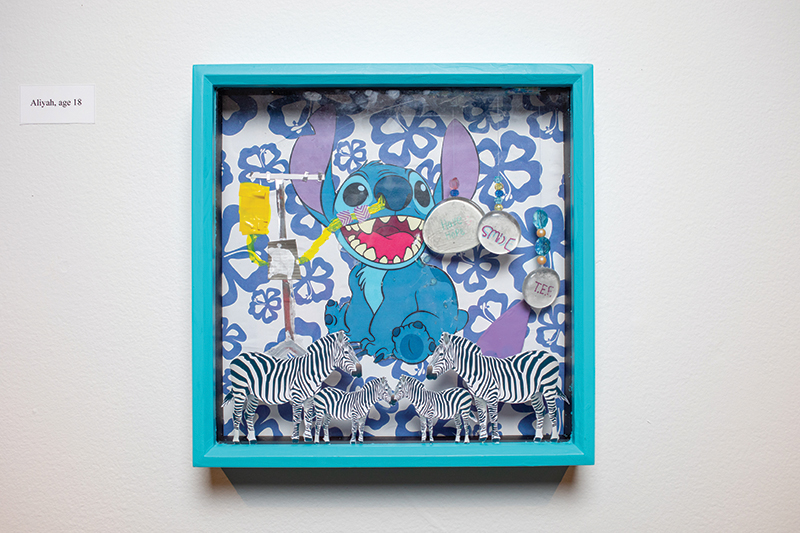
Art as Wellness: UMOCA’s See Me Exhibit
Art
See Me is the latest exhibit residing in UMOCA’s “Ed Space” that challenges our perception of the role of art in daily life. Through June 1, the space is dedicated to art made by six child artists and hospitalized youth from Primary Children’s Hospital. Exhibited are a series of shadowboxes that display unique journeys to physical and mental wellness, reminding us of art’s capacity as a therapeutic tool, something many adults tend to forget. With age, art slips into becoming something other people do—your role is to appreciate it, let it soothe you, heal you. We forget that making art can be the thing that heals, that you don’t need to be a master to be afforded the benefits of trying. Maybe most importantly, you can witness and support just how expressive a child can be.
The young artists were asked a simple question: “If you could look inside someone’s heart and mind, what would you see?” It’s a heavy premise for any artist to tackle, especially a child, but curator of education Erin Hartley of UMOCA found the work they produced surprising when bringing it to the museum. Hartley collaborated with Juniper Monypenny, an art therapist, to make it happen. “When setting up the exhibition with Juniper, I knew that it would be a series of shadowboxes, but had no idea what they would contain,” Hartley says. “The end result was surprisingly sweet and endearing. When I learned the [artists’] ages and names, I felt grateful that I could work with such thoughtful and creative youth.”
“In a contemporary art museum, all the pieces of work are in some way meant to be emotional and start a conversation with the viewer.”
The works the kids have produced are interesting to look at in this light. A piece by Cullen, 10, uses patterned paper, clay, wires, marbles and cutouts to depict astronauts floating in space around a rocket, surrounded by dozens of stars. Evelin, 10, has created a Noah’s Ark–like scene using popsicle sticks, clay and toy animals, with mandala art casting a shadow over the scene. Allison, 7, has cacti, trees and hearts surrounding two pink clay creatures, one looking like a unicorn. Above the shadowbox is a black paper with oblong faces etched in, one on top another, as though they are looking down, ominous yet caring, scrying the scene below.
It was always intended that these pieces would have a wider audience. “The pieces in this show were worked on slowly over many sessions,” says Monypenny. “With [artists] for whom sharing their story with others and feeling connected to a greater community has been beneficial … we approached [them] with the explicit understanding that the art products would be shared with the community to tell their stories and communicate their ideas.” It’s important to remember that when we as a community patronize these events and these works, we’re supporting the creative healing process artists are working through. We uphold vulnerability and validation as community values.
“In a contemporary art museum, all the pieces of work are in some way meant to be emotional and start a conversation with the viewer,” Hartley says. “It should be the job of the artists to tell a story through their medium and the viewers job to interpret through their own memories and feelings. Whether that be a story of healing, environmentalism or [a] political message, it’s our perspective and personal connection that we remember.”

The conversation started here goes beyond the question of what you might see if you could peer inside another person—I’m left reminded that one of the most worthwhile feelings a piece of art can leave you with is empathy for the artist themself. All people live with a rich interiority, young or old, and to work through that and put it on display is a brave thing. “An art-therapy session might be mixing colors of soft, soothing clay while speaking about memories of an accident,” says Monypenny. “It could take the form of using paint daubers aggressively to expend a child’s anxious energy before a scary procedure.”
Hartley believes in the programs that create these opportunities for young people’s vulnerable communication. “In its own way, art can be therapeutic and helpful for many, and just getting out to a creative workshop or Family Art Saturday can make anyone feel good,” she says. “There are a number of programs that the museum has to outreach as a source of helpful art workshops. We have our Out Loud program that helps LGBTQ+ youth connect and make art together, and we work with the Office of Crime Victims to create workshops that help us ‘Heal Through Art.’”
If nothing else, See Me is a small opportunity to celebrate that some of the most important art comes from young people, whose moxie and vitality rival that of any grown adult. Having a space to remember this feels like a gift.
You can see these works at the Utah Museum of Contemporary Art through June 1 on 20 S. West Temple in the museum’s Ed Space. Visit utahmoca.org for more info and to plan a visit.
More on SLUGMag.com:
Pulitzers and You: Imagining a Better Future
Come Together: The International Tolerance Project